# 【CSS进阶】选择器进阶笔记(2)伪类
接上一个选择器进阶笔记(1) (opens new window),CSS选择器还有伪类这一重要的组成部分。
# 一、CSS3之前的伪类
CSS3之前的伪类主要如下图所示👇

表中:first-letter和:first-line都是生面孔,不过看字面意思应该也能猜出他的作用。。。
测试一下:
<style>
p:first-letter {
font-size: 20px;
font-weight: 700;
}
p:first-line {
color: red;
}
</style>
<div>
<p>
JavaScript (JS) is a lightweight, interpreted, or just-in-time compiled programming language with first-class functions.
<br>
While it is most well-known as the scripting language for Web pages,
many non-browser environments also use it, such as Node.js, Apache CouchDB and Adobe Acrobat.
</p>
<p>
JavaScript (JS) is a lightweight, interpreted, or just-in-time compiled programming language with first-class functions.
While it is most well-known as the scripting language for Web pages,
many non-browser environments also use it, such as Node.js, Apache CouchDB and Adobe Acrobat.
</p>
</div>
1
2
3
4
5
6
7
8
9
10
11
12
13
14
15
16
17
18
19
20
21
22
23
2
3
4
5
6
7
8
9
10
11
12
13
14
15
16
17
18
19
20
21
22
23
图示:

WARNING
需要注意的是第一个p标签中是有一个<br>的,强制换行可以控制第一行要显示的内容。
# 二、CSS3中的伪类
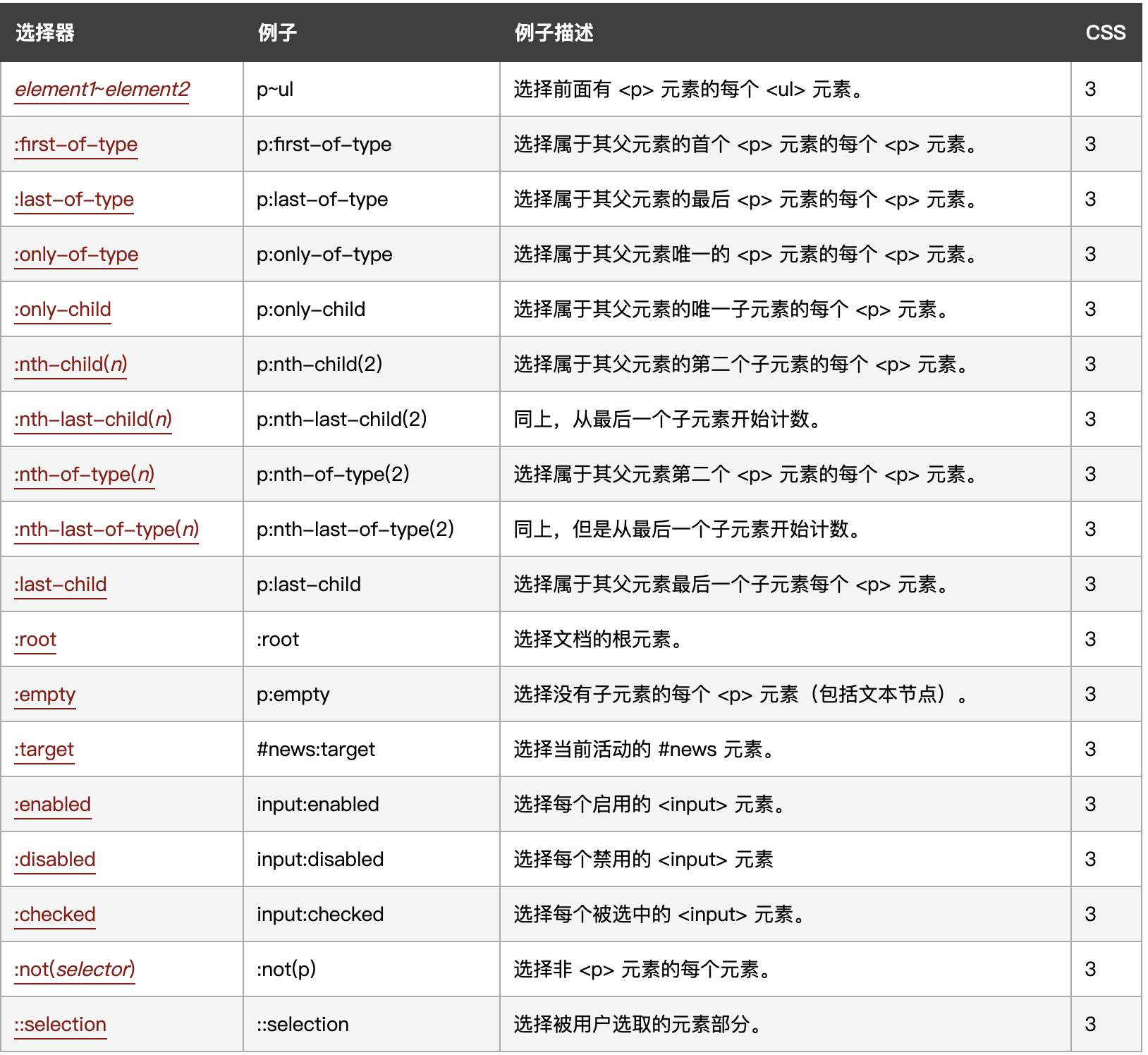
CSS3中新的伪类基本都在这儿了,但是光看例子描述基本没啥用,还是一个一个来试试,顺便混个眼熟。。
# 1.~
<style>
/* 选择前面是span元素的p元素 */
span ~ p {
color: red;
}
</style>
<div>JavaScript (JS) is a lightweight, interpreted, or just-in-time compiled programming language with first-class functions.</div>
<p>JavaScript (JS) is a lightweight, interpreted, or just-in-time compiled programming language with first-class functions.</p>
<span>mark</span>
<p>JavaScript</p>
1
2
3
4
5
6
7
8
9
10
11
2
3
4
5
6
7
8
9
10
11
图示:
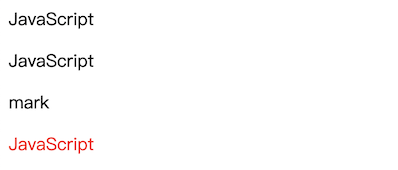
# 2.:first-of-type/:last-of-type/:only-of-type
<style>
/* first-of-type/last-of-type/only-of-type */
/* 同一个父元素下第一个p元素 */
p:first-of-type {
color: red;
}
/* 同一个父元素下最后一个p元素 */
p:last-of-type {
font-weight: 100;
}
/* 选择同一个父元素下只有一个<span>元素的元素 */
/* 这样写表述还是不够清楚,还是看实例1和2吧。。 */
span:only-of-type {
color: green;
}
</style>
<!-- 实例1 -->
<div>
<div>JavaScript</div>
<p>JavaScript</p>
<span>mark</span>
<p>JavaScript</p>
<span id="type">
mark2
<span>???</span>
<p>+++</p>
+++
<!-- <span>---</span> -->
</span>
</div>
<!-- 实例2 -->
<div>
<div>JavaScript</div>
<p>JavaScript</p>
<span>mark</span>
<p>JavaScript</p>
<span id="type">
mark2
<span>???</span>
<p>+++</p>
+++
<span>---</span>
</span>
</div>
1
2
3
4
5
6
7
8
9
10
11
12
13
14
15
16
17
18
19
20
21
22
23
24
25
26
27
28
29
30
31
32
33
34
35
36
37
38
39
40
41
42
43
44
45
46
47
48
2
3
4
5
6
7
8
9
10
11
12
13
14
15
16
17
18
19
20
21
22
23
24
25
26
27
28
29
30
31
32
33
34
35
36
37
38
39
40
41
42
43
44
45
46
47
48
图示:

-----------------------(👆实例1 👇实例2)-----------------------
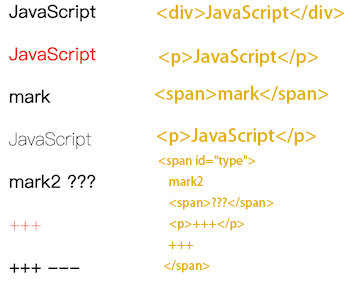
WARNING
可以发现only-of-type在仅适用于相同父元素下只有一个span元素,我多加了一个span元素,样式立马失效了。。
# 3.:only-child/:nth-child(n)/:nth-last-child(n)
<style>
/* 父元素下有且只有一个p元素的 */
p:only-child {
color: red;
}
</style>
<div>JavaScript0</div>
<div>
<p>JavaScript1</p>
<!-- 如果下面的span不注释,那么它的兄弟p元素中的文字将不会是红色 -->
<!-- <span>JavaScript1</span> -->
</div>
<div>
<p>JavaScript2</p>
<p>JavaScript2</p>
</div>
1
2
3
4
5
6
7
8
9
10
11
12
13
14
15
16
17
2
3
4
5
6
7
8
9
10
11
12
13
14
15
16
17
图示:
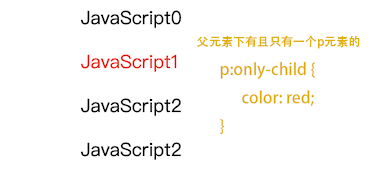
<style>
/* 父元素下第2个元素为p元素的 */
p:nth-child(2) {
font-weight: 200;
}
</style>
<div>JavaScript0</div>
<div>
<span>JavaScript1</span>
<p>JavaScript1</p>
<p>JavaScript1</p>
</div>
<div>
<p>JavaScript2</p>
<p>JavaScript2</p>
</div>
1
2
3
4
5
6
7
8
9
10
11
12
13
14
15
16
17
2
3
4
5
6
7
8
9
10
11
12
13
14
15
16
17
图示:
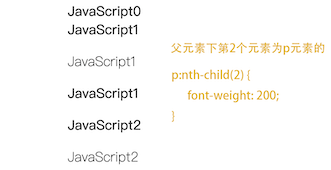
<style>
/* 选择倒数第二个p元素,只有倒数第二个元素为p元素时 */
p:nth-last-child(2) {
color: blue;
}
</style>
<div>
<div>JavaScript0</div>
<div>
<p>JavaScript1</p>
<p>JavaScript1</p>
<span>JavaScript1</span>
</div>
<div>
<p>JavaScript2</p>
<span>JavaScript2</span>
<p>JavaScript2</p>
</div>
</div>
1
2
3
4
5
6
7
8
9
10
11
12
13
14
15
16
17
18
19
20
2
3
4
5
6
7
8
9
10
11
12
13
14
15
16
17
18
19
20
图示:
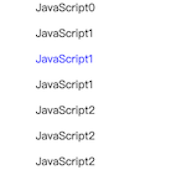
# 4.:nth-of-type(n)/:nth-last-of-type()/:last-child
以下几个伪类的测试HTML结构如下:
<div>
<div>JavaScript0</div>
<div>
<p>JavaScript1</p>
<p>JavaScript1</p>
<span>JavaScript1</span>
</div>
<div>
<p>JavaScript2</p>
<span>JavaScript2</span>
<p>JavaScript2</p>
</div>
</div>
1
2
3
4
5
6
7
8
9
10
11
12
13
2
3
4
5
6
7
8
9
10
11
12
13
/* 选择第二个p元素 */
p:nth-of-type(2) {
color: red;
}
1
2
3
4
2
3
4
图示:
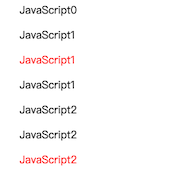
/* 自下而上,选择倒数第二个p元素 */
p:nth-last-of-type(2) {
color: red;
}
1
2
3
4
2
3
4
图示:
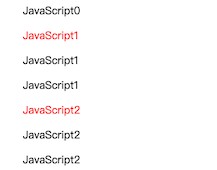
/* 选择最后一个p元素,只有最后一个元素为p元素时 */
p:last-child {
color: red;
}
1
2
3
4
2
3
4
图示:
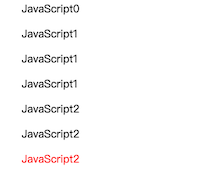
# 5.:root/:empty/:target/:enabled/:disabled/:checked
这几个其实都可以根据字面意思来理解。。
:root:选择根元素,特定用法,只能这么写,没有其他的像p:root这种什么的。。:root这样写将选择文档根元素,就是<html>。:empty:选择没有子元素的每个父元素 ,例如div:empty,就是选择每个下面没有子元素的div。:target:选择当前活动的HTML锚,DEMO详见CSS3 :target 选择器 (opens new window)。:enabled:选择启用的元素。:disabled:选择禁用的元素。:checked:选择被选中的元素,应用于checkbox。
# 6.:not(selector)/::selection
:not()是比较常用的,可以用来选择一堆兄弟元素中特殊的一个或多个。::selection没用过,不过可以试一下这个DEMOCSS3 ::selection 选择器 (opens new window),需要注意的是,这个选中是指鼠标右键按住拖移的选中。
